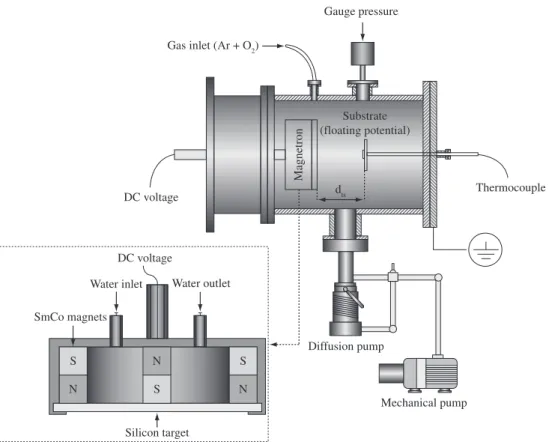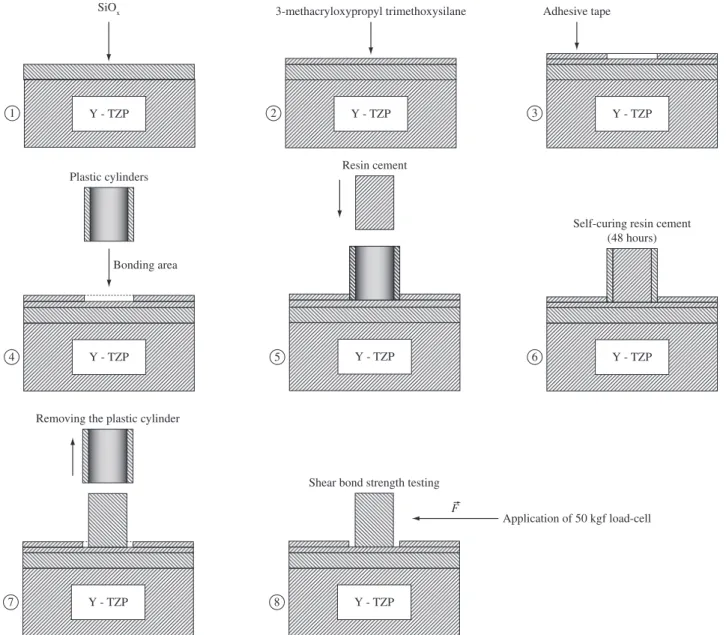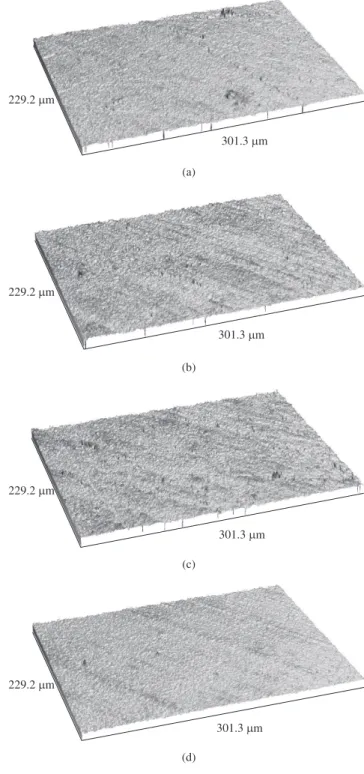*e-mail: daduarte@ita.br
Deposition of SiO
xThin Films on Y-TZP by Reactive Magnetron Sputtering:
Influence of Plasma Parameters on the Adhesion Properties Between
Y-TZP and Resin Cement for Application in Dental Prosthesis
José Renato Calvacanti de Queiroza, Diego Alexandre Duarteb*, Rodrigo Othávio de Assunção e Souzac,
Sara Fernanda Fissmerb, Marcos Massib, Marco Antonio Bottinoa
a
School of Dentistry, São Paulo State University – UNESP,
CEP 12245-000, São José dos Campos, SP, Brazil
b
Plasma Science and Technology Laboratory, Technological Institute of Aeronautics – ITA,
CEP 12228-900, São José dos Campos, SP, Brazil
c
Department of Restorative Dentistry, Federal University of Paraíba – UFPB,
CEP 58039-080, João Pessoa, PB, Brazil
Received: December 23, 2010; Revised: April 30, 2011
In this paper SiOx thin films were deposited on Y-TZP ceramics by reactive magnetron sputtering technique in order to improve the adhesion properties between Y-TZP and resin cement for applications in dental prosthesis. For fixed cathode voltage, target current, working pressure and target-to-substrate distance, SiOx thin films were deposited at different oxygen concentrations in the Ar+O2 plasma forming gas. After deposition processes, SiOx thin films were characterized by profilometry, energy dispersive spectroscopy (EDS), optical microscopy and scanning electron microscopy (SEM). Adhesion properties between Y-TZP and resin cement were evaluated by shear testing. Results indicate that films deposited at 20%O2 increased the bond strength to (32.8 ± 5.4) MPa.
This value has not been achieved by traditional methods.
Keywords: Y-TZP, dental material, thin films, silicon oxide
1. Introduction
Ytria-stabilized tetragonal-zirconia-polycrystalline (Y-TZP) is a biocompatible material that has excellent mechanical properties, such as, high flexural strength, fracture toughness and phase transformations through the stress generated in the appearance of cracks1,2. Since the first appearance of Y-TZP as dental material, it
has been increasingly used as infrastructure for metal-free prosthesis3,
however the lack of chemical interaction between resin cement and zirconia surface decreases the bond strength. Good adhesion mediated by the use of resin-based cement in this interface is important for high retention, prevention of microleakage in this interface and to increase fracture and fatigue resistances to all-ceramic crowns6. Many
surface treatments have been suggested in order to improve the bond strength between Y-TZP and resin cement as, for example, air particle abrasion with Al2O3 associated with the use of primers that contain adhesive monomers (4-methacryloxyethyl trimellitate anhydride or methacryloxy decyl phosphoric acid monomers) or tribochemical SiO2 coating associated to silane coupling agent application4. Both
surface treatments improve the bond strength between Y-TZP and resin cement5-7. However, the impact of particles can induce tetragonal
to monoclinic phase change on the zirconia surface. This region may contain microcracks and other flaws that could compromise long-term durability of Y-TZP7-11,14, which lead us to seek another method in
order to provide a reliable bond strength between these two materials without damage the Y-TZP surface for ensuring longevity with clinical success of zirconia-based prosthetic restorations.
Reactive magnetron sputtering deposition12,13 is a plasma
technique that presents as an efficient tool to be used in such
applications once the bombardment of high-energy particles on solid surfaces creates free radicals, which may be useful to increase the adhesion properties between two different materials without compromise the surface of the substrate. Thus, as the chemical modification of Y-TZP by plasma processing is not well understood, in this work reactive magnetron sputtering was used to deposit SiOx thin films on Y-TZP ceramics aiming to facilitate the adhesion properties between Y-TZP and resin cement.
2. Experimental Setup
Y-TZP ceramics with 15 mm in diameter and 1.2 mm in thickness were sinterized at 1500 °C, polished and ultrasonically cleaned for 5 minutes in de-ionized water. Experiments were carried out in a vacuum chamber (schematically shown in Figure 1) evacuated to a background pressure of 5.0 × 10-5 Torr (~0.7 × 10-3 Pa). Cathode
voltage, target current, working pressure and target-to-substrate distance (dts) were fixed at (500 ± 5) V, (0.50 ± 0.05) A, (20 ± 1) mTorr
(~2.7 Pa) and (48 ± 1) mm, respectively. As sputtering source a silicon
target (99.999%) was used and SiOx thin films were deposited on Y-TZP at 20, 40 and 60%O2 in Ar+O2 gas mixture. During deposition processes, all substrates attained at maximum 105 °C. After deposition processes, films were analyzed by optical profilometry (Veeco Wyko NT 1100), optical microscopy (Mitutoyo MF-A), electron dispersive spectroscopy (EDS), scanning electron microscopy (SEM) (LEO 435 VPi and Zeiss DSM 950) and by a universal testing machine (EMIC DL-100). Films thicknesses were measured by optical
Materials Research. 2011; 14(2): 212-216 © 2011
profilometry (optical interference microscopy) in order to calculate the deposition rate that was done by taking the ratio between film thickness and deposition time (30 minutes). Also, optical profilometry was employed in order to analyze the surface topography through digital images and the roughness mean value (Ra) of deposited films. The adhesion properties between Y-TZP ceramic and resin cement were studied as described schematically in Figure 2. The bonding agent 3-methacryloxypropyl trimethoxysilane was applied on SiOx for curing for 180 seconds (step 2 in Figure 2). The bonding area of each sample was limited by an adhesive tape with 2.3 mm in hole diameter (step 3). The resin cement was placed into the transparent plastic cylinders (2.3 mm in diameter and 3.0 mm in thickness) and, then, both were fixed on the 3-methacryloxypropyl trimethoxysilane (steps 4 and 5). After this process, samples were stored into de-ionized water at room temperature (37 °C) for self-curing for 48 hours (step 6). After removing the plastic cylinder (step 7), the shear bond strength test was performed by application of a 50 kgf load-cell on the ceramic-cement interface in a speed of 1.0 mm/min (step 8). After shear testing, fractured samples were analyzed by optical microscopy and scanning electron microscopy. In addition, other sample without SiOx was made in order to compare the bond strength with those that use SiOx as intermediate adhesive layer.
3. Results and Discussion
3.1. Profilometry
As shown in Figure 3, deposition rate of SiOx thin films decreases from approximately 30 to 5 nm/min as the oxygen concentration in the gas discharge increases from 20 to 60%. This effect is caused
by the well-known process of target poisoning (oxidation) that decreases the sputtering yield of the target and, as consequence, the condensing atom flux toward the Y-TZP ceramic surface. According to Hattum et al.15 as the oxygen flow rate increases, the gas discharge
is characterized by a suddenly decrease of silicon atoms toward the growing film and, at the same time, SiOx molecules is increased, which indicates the covering of target and substrate by compound. Further, results indicate that surface roughness was not significantly modified as the oxygen concentration in the gas discharge increases. The roughness mean value of the films was found to be (357 ± 61) nm,
(391 ± 69) nm and (366 ± 73) nm at 20, 40 and 60%O2, respectively. The roughness mean value of the Y-TZP surface without SiOx film is (380 ± 32) nm. Then, one can conclude that no significant
modifications in Ra were observed once these values are much smaller than those achieved by sandblasting technique16.
3.2. Energy dispersive spectroscopy (EDS)
Silicon oxide is a wide band gap material (9.0 eV) thereby it is transparent when deposited on Y-TZP. Thus, in order to confirm the presence of silicon on the substrates, EDS analyzes were conducted. In Figure 4 is possible to observe that the silicon concentration (C[%Si]) on the Y-TZP, regarding the zirconia concentration (C[%Zr]), decreases as the oxygen concentration increases from 20 to 60%. This is caused by decrease of the film thickness, which contributes to increase the relative concentration of zirconia on the substrate surface. Films deposited at 40 and 60% have thickness below 150 nm and as the electron beam in EDS penetrates much more than this value, the results from Figure 4 must be taken only as complementary to the profilometry data, i.e. as thinner the film is, smaller will be the relative concentration of silicon in the film.
Queiroz et al.
Figure 2. Steps for preparation of the samples used for shear test: 1) SiOx films deposition on Y-TZP substrate; 2) deposition of 3-methacryloxypropyl
trimethoxysilane on SiOx films; 3) limitation of the bonding area by an adhesive tape; 4) fixation of transparent plastic cylinders; 5) deposition of resin cement into the plastic cylinder; 6) self-curing of resin cement for 48 hours; 7) removing the plastic cylinder and 8) shear test through application of the 50 kgf load-cell on the resin cement. Step (1) was not employed to the sample without SiOx. Figures are not to scale.
Figure 3. Film thickness and deposition rate of SiOx thin films as function of oxygen concentration in the gas discharge.
Figure 4. Relative concentration of silicon in the SiOx thin films as function of oxygen concentration in the gas discharge.
3.3. Shear testing, optical microscopy and scanning electron
microscopy (SEM)
Bond strength decreases from approximately 33 to 15 MPa as the oxygen concentration increases from 20 to 60%, as shows Figure 5. The bond strength without SiOx film is (11.5 ± 4.5) MPa so that one can observe an interesting increase of the bond strength between Y-TZP and resin cement when SiOx film is used as an intermediate adhesive layer. At low oxygen concentrations, the gas discharge is predominantly composed by metallic vapor and argon, which means that at low concentration, Y-TZP surface has a considerable presence of silicon atoms, as described in Figure 4. Thus, the higher bond strength at 20%O2 may be attributed to the higher presence of silicon on Y-TZP surface15,17 that probably makes the silicon oxide
grow in a sub-stoichiometric form (0 < x < 2). This structure is more reactive and has higher chemical affinity to silane in comparison with stoichiometric SiO2. Then, it may be an indicative that the chemical affinity of SiOx thin films to silane is strongly correlated to the non-stoichiometric form, i.e. the bond strength is higher for SiOx deposited with x < 2. Snyders et al.18, based on the Berg’s model to the modeling
of reactive sputter deposition, reported that the oxygen concentration in the gas discharge influences directly the film stoichiometry but more studies regarding this issue must be taken into account in order to evaluate the effect of the film stoichiometry on the bond strength. In addition, at lower oxygen concentrations the plasma sheath in front of the film supports higher potential drop thus more energetic bombardment is promoted by Ar ion flux. This ion impact may cause formation of films with higher roughness, lattice defects and large amount of peaks and valleys12,13 where all these effects
play an important role to increase the bond strength between Y-TZP and resin cement. On the other hand, as the surface modification by ion bombardment in reactive magnetron sputtering discharges is about of few nanometers13, it was not possible to observe significant
modifications on the films surface by images of optical profilometry in Figure 6. Although it can be seen that films surface deposited at lower oxygen concentrations (20 and 40%) are slightly more irregular than film deposited at 60%O2, which may also explain the increase of the bond strength to the films deposited at low oxygen concentrations.
The increase of the bond strength when zirconia surface is sandblasted with alumina or silica particle associated with zirconia primer is reported elsewhere11,14,16 but the deposition of SiO
x thin films
between Y-TZP and resin cement as an intermediate adhesive layer has not been studied yet. Although results do not show significant modifications on the surface roughness with deposition of SiOx films
Figure 5. Shear strength between Y-TZP and resin cement as function of the oxygen concentration in the gas discharge. Samples prepared according to the steps of Figure 2.
Figure 6. Images of optical profilometry (229.2 × 301.3 µm) before shear test for a) Y-TZP surface, b) SiOx deposited at 20%O2, c) SiOx deposited at 40%O2 and d) SiOx deposited at 60%O2.
as achieved by sandblasting16, this method presents as efficient way
to improve the adhesion properties between Y-TZP and resin cement without damage the Y-TZP surface, i.e. the bond strength is based mainly by chemical bond. In addition, this new method increases the bond strength to high values without compromise the quality of the substrate surface, which in traditional methods as, for example, in sandblasting it is not possible. Özcan et al.9 evaluated the influence
of different surface treatments on the shear bond strength between Y-TZP ceramic surface and resin cement and they found values between 8.23 and 12.02 MPa. Blatz et al.14 have reported higher
Queiroz et al.
Acknowledgements
Authors would like to thank FAPESP, CNPq and CAPES by financial support and the National Institute for Space Research by profilometry, EDS and SEM measurements.
References
1. Giordano R. Materials for chairside CAD/CAM-produced restorations. The Journal of the American Dental Association. 2006; 137(1):14S-21S. PMid:16950933
2. Conrad HJ, Seong WJ and Pesun IJ. Current ceramic materials and systems with clinical recommendations: A systematic review. The Journal of Prosthetic Dentistry. 2007; 98(5):389-404. doi:10.1016/S0022-3913(07)60124-3 3. Martin N and Jedynakiewicz NM. Clinical performance of CEREC ceramic
inlays: a systematic review. Dental Materials. 1999; 15(1):54-61. doi:10.1016/ S0109-5641(99)00014-7
4. Blatz MB and Swift EJ. Adhesive cementation of high-strength ceramics. Journal of Esthetic and Restorative Dentistry. 2007; 19(5):238-239. PMid:17877619. doi:10.1111/j.1708-8240.2007.00109.x
5. Kitayama S, Nikaido T, Maruoka R, Zhu L, Ikeda M, Watanabe A et al. Effect of an internal coating technique on tensile bond strengths of resin cements to zirconia ceramics. Dental Materials Journal. 2009; 28(4):446-453. PMid:19721282. doi:10.4012/dmj.28.446
6. Piascik JR, Swift EJ, Thompson JY, Grego S and Stoner BR. Surface modification for enhanced silanation of zirconia ceramics. Dental Materials. 2009; 25(9):1116-1121. PMid:19376572. PMCid:2720441. doi:10.1016/j.dental.2009.03.008
7. Derand T, Molin M and Kvam K. Bond strength of composite luting cement to zirconia ceramic surfaces. Dental Materials. 2005; 21(12):1158-1162. PMid:16005508. doi:10.1016/j.dental.2005.02.005
8. Bottino MA, Valandro LF, Scotti R and Buso L. Effect of surface treatments on the resin bond to zirconia-based ceramic. The Journal of Prosthetic Dentistry. 2005; 94(4):369-374. doi:10.1016/j.prosdent.2005.05.011
9. Özcan M, Nijhuis H and Valandro LF. Effect of Various Surface Conditioning Methods on the Adhesion of Dual-cure Resin Cement with MDP Functional Monomer to Zirconia after Thermal Aging. Dental Materials Journal. 2008; 27(1):99-104.
10. Zhang Y, Lawn BR, Malament KA, Thompson VP and Rekow ED. Damage Accumulation and Fatigue Life of Particle-Abraded Ceramics. The International Journal of Prosthodontics. 2006; 19(5):442-448. PMid:17323721
11. Nothdurft FP, Motter PJ and Pospiech PR. Effect of surface treatment on the initial bond strength of different luting cements to zirconia oxide ceramic. Clinical Oral Investigations. 2009; 13(2):229-235. PMid:18758827. doi:10.1007/s00784-008-0222-8
12. Duarte DA, Massi M, Silva Sobrinho AS, Maciel HS, Grigorov K and Fontana LC. Titanium dioxide thin films deposition by direct current hollow cathode magnetron sputtering. The European Physical Journal Applied Physics. 2010; 49:13107. doi:10.1051/epjap/2009179
13. Toku H, Pessoa RS, Maciel HS, Massi M and Mengui UA. The effect of oxygen concentration on the low temperature deposition of TiO2 thin films. Surface and Coatings Technology. 2008; 202(10):2130.
14. Blatz MB, Sadan A, Martin J and Lang B. In vitro evaluation of shear bond strengths of resin to densely-sintered high-purity zirconia-oxide ceramic after long-term storage and thermal cycling. The Journal of Prosthetic Dentistry. 2004; 91(4):356-362. PMid:15116037. doi:10.1016/j.prosdent.2004.02.001 15. Van Hattum ED, Palmero A, Arnoldbik WM and Habraken FHPM.
Experimental characterization of the deposition of silicon suboxide films in a radiofrequency magnetron reactive sputtering system. Surface and Coatings Technology. 2004; 188-189:399-403. doi:10.1016/j.surfcoat.2004.08.034 16. Sato H, Yamada K, Pezzotti G, Nawa M and Ban S. Mechanical properties of dental
zirconia ceramics changed with sandblasting and heat treatment. Dental Materials Journal. 2008; 27(3):408-414. PMid:18717169. doi:10.4012/dmj.27.408 17. Palmero A, Van Hattum ED, Rudolph H and Habraken FHPM. Characterization
of an Ar/O2 magnetron sputtering plasma using a Langmuir probe and an energy resolved mass spectrometer. Thin Solid Films. 2006; 494(1-2):18-22. doi:10.1016/j.tsf.2005.07.154
18. Snyders R, Wautelet M, Gouttebaron R, Dauchot JP and Hecq M. Experimental and theoretical study of the role of the gas composition and plasma-surface interactions on the SnOx films stoichiometry prepared by DC magnetron reactive sputtering. Thin Solid Films. 2003; 423:125-130. doi:10.1016/S0040-6090(02)01066-0
particle abrasion method with Al2O3 with 50 µm grain size. On the other hand, Nothdurft et al.11 using air particle abrasion method with
Al2O3 with 110 µm grain size attained values around 25.11 MPa. However, all reported data are lower than the bond strength reported in the present study, i.e. lower than (32.8 ± 5.4) MPa.
In Figure 7(a), optical microscopy without deposition of SiOx shows adhesive failures between Y-TZP and resin cement while to the others is observed adhesive and cohesive failures. In Figure 8, SEM images to the film deposited at 20%O2 show adhesive failures between SiOx and resin cement, as well as, cohesive fractures of the resin cement and nanospots show adhesive failures between SiOx and Y-TZP. All these results from Figures 7 and 8 indicate a strong adhesion of the SiOx films with the Y-TZP surface and resin cement.
4. Conclusions
In this work was studied the bond strength between Y-TZP substrates and resin cement through deposition of SiOx thin films between these two materials by reactive magnetron sputtering technique at different oxygen concentrations in the Ar+O2 plasma forming gas. Results show that SiOx films deposited by reactive magnetron sputtering is an efficient and alternative way to improve the bond strength between resin cement and Y-TZP to prosthetic dentistry once deposition of SiOx films on Y-TZP increased the bond strength to (32.8 ± 5.4) MPa and this value has not been achieved
by traditional methods.
Figure 7. Images of optical microscopy (×60) for fractured samples after shear test: a) Y-TZP surface, b) SiOx deposited at 20%O2, c) SiOx deposited
at 40%O2 and d) SiOx deposited at 60%O2.
Figure 8. SEM images a) ×1000 and b) ×5000 for the fractured film after shear test (film deposited at 20%O2). RC means “resin cement”.



